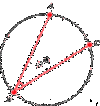Finals Flashcards
(227 cards)
degrees → radian
degree • pi/180
radians → degree
radian • 180/pi
evaluate sin x, cos x, and tan x for a value x
- if necessary, convert x to degrees
- Check what quadrant it’s in
- Do whatever the quadrant says to do
- Use special/quadrantal angles tables to solve
special angles table

quadrantal angles table
y = sin x graph → 0 1 0 -1 0
y = cos x graph → 1 0 -1 0 1
tan x = sinx/cosx

state the number of revolutions for an angle
- convert to radians
- radians/2pi
convert to decimal degree form
Ex: 152o15’29”
152 + (15/60) + (20/3600) =
152.26o
decimal degree form
156.33o
DMS form
122o25’51”
convert to DMS form
Ex: 24.240
24o(.24*•60)’ (.4**•60)”
24o14’24”
*.24 is from 24.24
**.4 is from (.24•60 = 14.4)
1’ = ?
one minute = (1/60)(1o)
1” = ?
one second = (1/60)(1’) = (1/3600)(1o)
quadrant rules

terminal ray
the pipe cleaner
in which quadrant does the terminal side of each angle lie when it is in standard position?
- convert to degrees
- if negative, + 360; if over 360, - 360
- find which quadrant it’s in
find the exact value of sin/cos/tan x. no calculator.
- if radians, convert to degrees
- use quick charts
use a calc to approximate sin/cos/tan x to four decimal places
- if degree, change calc to Degree mode
- if radians, change calc to Radians mode
sketch w/out a calculator a sin/cos/tan curve
xmin = -2pi
xmax = 2pi
xscl = pi/2 (unless stated otherwise)
ymin = -5
ymax = 5
yscl = .5
sin, cos
- if y = c + cos(x) → period & amplitude same; c = pos moves max/min up, c = neg moves max/min down
- if y = a sin(x) → period same; move max to a
- if y = sin(bx) → max/min/amp same; normal period/b
- if y = sin(x + b) → if b = pos, move left; if b = neg, move right
**tan, cot, sec, csc - **no ampl/min/max
- y = c + tan(x) → if c = pos, move up; c = neg, move down (easier to just move x-int’s)
- y = a csc(x) → move min/max’s to a
- y = cot(bx) → period/b
period
- for sin, cos curves → the shortest distance along the x-axis over which the curve has one complete up-and-down cycle
- for tan, distance b/w consecutive x-intercepts
amplitude
max - min
vertical asymptotes
lines that the graph approaches but doesn’t cross
periodic
repeating
Ex: tan function
csc, sec, cot
csc = 1/sin
sec = 1/cos
cot = 1/tan
what happens to y = csc(x) whenever y = sin(x) touches the x-axis?
vertical asymptote



































